For connoisseurs of the historic racing scene, the Goodwood Revival Meeting no longer needs an explicit introduction. Once a year, the best historic racers in England compete with equally daring foreigners on the fastest historic circuit in the world, where real races are still held with adequate vehicles.
The fact that, with the exception of the pre-war racing cars, many of the vehicles are newly built or rebuilt is irrelevant. The cars look, smell and sound just as they did at the time when national races and major international events were held at Goodwood from 1948 to 1966.
Launched in 1998 by the grandson of the then founder of the circuit, Freddy March, the revival has now been running for just as long as it did in the middle of the last century.
Lively theater
The majority of spectators, who come from all over the world, dress as they did in the old days, making the Goodwood Revival Meeting a unique theatrical event. If you like pure racing and have never seen it live, it's your own fault, but you still have plenty of opportunities to do so, as its future seems assured for years to come thanks to the immense crowds.
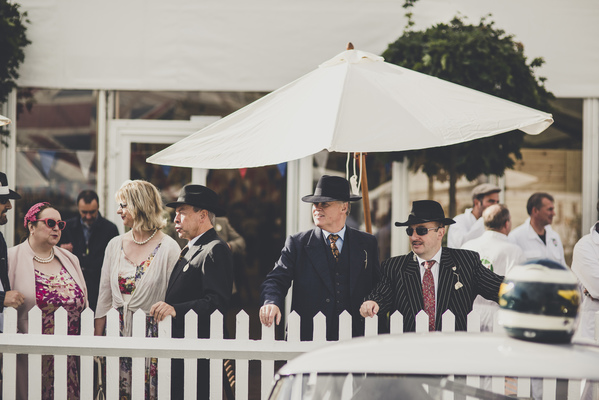
Although the date for 2017 has not yet been set, it is likely to be around mid-September after the last European Grand Prix. This is because Lord March, whose estate is home to the Goodwood Circuit built by his grandfather, attaches great importance to a large number of racing celebrities, who tend to be available on Formula 1-free weekends.
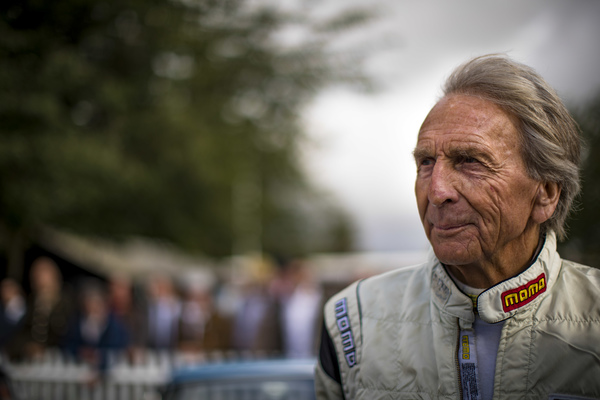
However, many a current GP driver would be terrified if they had to drive as fast here as their predecessors Jim Clark and Jackie Stewart once did. The two former British Formula 1 world champions have jointly held the absolute lap record since April 19, 1965 with an average speed of 107.46 mph (172.9 km/h). Although the V8 super sports cars have already beaten the record several times at the Revival, the Goodwood organizers are sticking to the legendary record of their two heroes.
Rain on the first race day
Another thing that has not changed since then is - sorry for this prejudice - the weather on the British Isles. After it had only rained briefly in the early morning on the first day and then the sun appeared between the clouds, it started to rain on Saturday just before 10am and lasted until after 4pm.
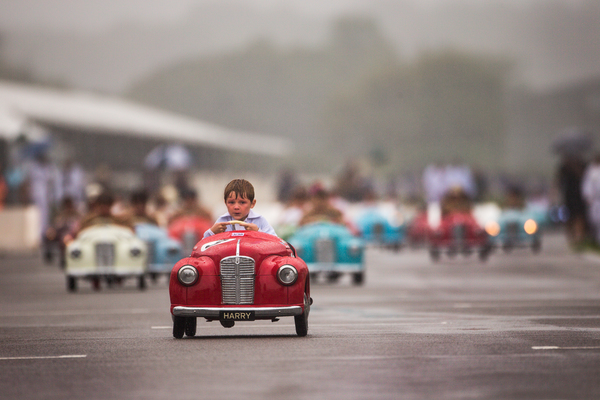
This put the riders in all fields to the test, as well as those spectators who had not secured a ticket for the covered grandstands or a place in the overcrowded tents. However, in the beautiful late summer weather that presented itself on Sunday, it was fun to stroll around all day and watch the racing action from the natural grandstands around the 3.86 km circuit.
Ferrari win in the first GT race
On Friday evening, when unfortunately many of the 45,000 daily spectators were already making their way home, a one-hour race for closed GT cars built up to 1962 was already on the program. As in qualifying, the Ferrari 250 GT SWB/C of Joe Macari and Tom Kristensen set the tone - the Danish driver's victory was to remain the only one by a driver from a non-English-speaking country all weekend!
However, this victory was not that clear-cut, because without the safety car and accidents involving two DB4 GTs, the result might have looked very different.
With the active help of successful specialist Simon Hadfield, Wolfgang Friedrichs brought his Aston Martin DB4GT home in second place, 7.5 seconds behind. The best of the ten Jaguar E-Types came third with the duo Ian Dalglish/Roger Wills.
Lukas Hüni and Carlo Vögele brought the unique Ferrari 330 GTO over the distance in tenth position.
Frank Stippler and Conrad Ulrich, also competing under the banner of Scuderia del Viadotto in a Ferrari 250 GT SWB, followed in 15th place, around a minute behind.
Urs Müller from Basel alternated with his daughter Arlette at the wheel of their Aston Martin DB4 GT, and they saw the chequered flag just under five seconds later in 16th place out of 23 drivers.
First Maserati victory in ten years
Surprisingly, it was Italy before England in the first race on Saturday. Calum Lockie's best time in practice gave an indication of his strength and that of a Maserati 6CM, but when the rain set in, multiple Goodwood winner Mark Gillies showed off his driving skills in the 1934 ERA A-type R3A.
It was only when Gillies briefly visited his pit crew with a technical problem that Lockie took the clear lead. "Even though we Brits are used to rain, it was really hard work. I would have preferred a dry track," admitted the winner.
Spinning wheels on the long straight
Just how difficult the conditions were was indicated by the numerous pirouettes in the field, all of which were harmless. Gillies also spun briefly into the green and finished his race to catch up in ninth position after the pit stop.
Matt Grist finished around seven seconds behind in an Alfa Romeo Tipo B, just ahead of Tom Dark in a 1945 Bugatti Type 73C. For the first time in ten years, the last time there was a Maserati victory in this annually programmed field, none of the otherwise dominant ERA drivers achieved a podium finish.
Just how difficult the narrow-tyred pre-war racing cars are to tame could be seen and heard in the example of Julian Majzub's Alfa Romeo 308C, whose rear tires spun in every gear when accelerating out of the chicane down the entire start/finish straight!
Chippings in the last chicane
The small and lighter 1600cc and two-liter sports cars, which were often seen at Goodwood from 1960 to 1964, also demanded a great deal of skill from their drivers, although some seemed to handle them with ease. After an initial lead by polesitter Chris Goodwin in one of the many Lotus 23Bs, Joe Twynman took command in an Elva-Ford Mk7.
The Brit seemed to pull away slightly, but came under increasing pressure from Andrew Newall towards the end of the 25-minute race. The latter had previously had a good battle with his Lotus colleagues Andrew Hibberd and Goodwin.
When Twynham saw his pursuer getting bigger and bigger in the rear-view mirror on the last lap, he wanted to quickly overtake another competitor in the chicane, but the latter was not expecting this. A collision promptly occurred, which ended for the straggler with unmistakable bodywork damage to the Lotus, while Twynham just managed to cross the finish line ahead of Newall in first place.
The stewards did not consider Twynham's maneuver to be an ordinary racing accident and subsequently penalized him 20 seconds, dropping him to fifth place. In addition, three penalty points were added to his racing license.
Behind the retrospective winner Newall and Hibberd, Max Bartell was the first driver to cross the finish line in an Elva Mk7S powered by a BMW two-liter engine. Rudolf Ernst finished 18th in the inferior DRW-Hillman Mk6 (only 1100 cc) and was at least significantly faster than the two last-placed drivers with Twincam and BRM engines.
Big show of small cars
This year, the St Mary's Trophy for touring cars was reserved for the small Austin A30 and A35, which even have their own one-make cup in England. These cute little cars look old-fashioned, but are almost all new builds. To ensure that everything was done properly, all 1300cc engines were checked and sealed, so that with a power spread of 85 to 86 hp, it was possible to speak of equal opportunities.
It was surprisingly civilized, which spoke for the quality of the drivers, as there were many stars from different motorsport categories, led by some drivers from the British Touring Car Championship. Victory went to Andrew Jordan, who won the duel with his BTCC colleague Gordon Shedden by 144 thousandths, but needed the third engine (!) on the Goodwood weekend to do so. The soon-to-be 65-year-old former BMW works driver Steve Soper finished a good third, a few car lengths back, ahead of former GP driver Mark Blundell.
Impressive race to catch up by the Swiss Austin A35
Frank Stippler, who started from the back of the field in the newly built A35 of Swiss driver Alex Boller in England and finished ninth, put in an equally astonishing performance as the winner. "Because we received around 60 requests for the 30 starting places, we were only on the reserve list and were not allowed to practice," said Boller, explaining the reason for the last starting position. "However, as we had hoped that someone would drop out, we kept ourselves ready."
With his rollover in training, a competitor actually did the Swiss team this favor, but Boller and his assistant Ruedi Stoop had to wait until 9.30 a.m. on race day for the okay from race control. The German racing pro then set off on the aforementioned race to catch up without having raced a single meter. Because the stewards could hardly believe that it was possible to make up 21 places in 25 minutes in such a high-caliber field with so many identical cars, they meticulously checked the Austin again but found nothing suspicious. This was to be expected.
Homage to 80 years of BMW 328 engines
Quiz question: What do the BMW 328, Frazer Nash Le Mans, Targa Florio and Mille Miglia, AC Ace-Bristol and Cooper-, Tojero- and Lister-Bristol have in common? That's right, they all have the same 1971 cc engine from Munich or its basis under the hood.
To mark the 80th anniversary of the 328 model launched in 1936, these sports cars with drum brakes, which appeared in different variations, were allowed to compete in their own race over 20 rainy minutes.
Right from the start, Martin Hunt in the 1953 Frazer Nash Le Mans Replica took the lead ahead of Malcolm Harrison's Cooper-Bristol T25 of the same age. The latter managed to overtake the leader in the final kilometer, relegating three different Frazer Nash types - Le Mans ahead of Targa Florio and Mille Miglia - to the places behind him. The first AC arrived in eighth place, the fastest of the four almost 80-year-old BMW 328s in 20th position.
Sensitive handling of the V8 cars
The 27 drivers in the Whitsun Trophy, which is a highlight of the Revival every year, needed an extremely fine throttle foot to control the available V8 power. Two Lola-Chevrolet T70 Spyders and a Lotus 19-Oldsmobile formed the front row of the grid, which the fastest driver in practice, Mike Whitaker, reached after a spin on the formation lap with heart palpitations and tufts of grass in front of the front radiator.
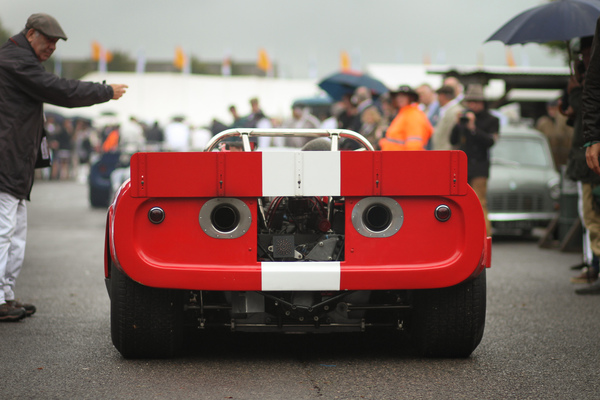
Warned in this way, he initially let Rob Huff in the Lotus and Tony Sinclair in his Lola go first, before Whitaker took the reins from the third lap onwards. With lap times 30 seconds slower, the fastest super sports cars were about as slow as the pre-war racing cars had been hours earlier, also on a wet track!
This was one of the reasons why Rob Huff seized the opportunity, with 200 hp less under the hood of the 1962 Lotus 19, to hold his own against the Lola, which was three years younger. After the 2012 World Touring Car Champion had followed him like a shadow, Huff overtook Whitaker on the 11th of 13 laps and won by eight tenths of a second.
Huff, as well as Whitaker and many other competitors in this impressive field of brute sports prototypes, said they had never driven in such conditions before. "So," said Whitaker, "it was a guessing game as to how to handle these cars."
Despite a detour into the botany on the starting lap and a spin on the penultimate lap, Silverstone race instructor Chris Ward finished fourth and best driver in a Ford GT40. His drifts and aggressive overtaking maneuvers with the wickedly expensive car from JD Classics were breathtaking. It is a testament to the skill and discipline of all the drivers that only two cars were eliminated in this race.
Abort after slips
It was only in the last race of the day, when the rain finally stopped and the racing line slowly dried out, that the safety car had to be deployed due to Conrad Ulrich's Maserati 300S getting stuck in the gravel. When Jochen Mass later planted his Mercedes 300 Gullwing in the gravel at the same spot, race control stopped the race five minutes before the end. The question of whether Richard Woolmer in the HWM Cadillac would have withstood the pressure from Rob Hall in the Aston Martin DB3 over the full distance remains unanswered.
Lukas Hüni was classified ninth in his Maserati A6GCS, Christoph Rendlen 13th in the Ferrari 500 TRC.
Formula Junior winner from the second row of the grid
On Sunday, the weather in the south of England was at its best, providing the participants in the other races with ideal conditions. In the Chichester Cup for front-engined Formula Junior racing cars from 1958 to 62, Stuart Roach, who was fastest in practice in the Alexis-Ford Mk2, seemed to be heading for a safe victory before he fell victim to a defect on the third-last lap. On the very first lap, Ray Mallock, who had started alongside him in the square-edged U2-Ford Mk2 - a popular car built by the Mallock racing dynasty in England - had already rolled out.
However, the profiteer was not Chris Drake in the Terrier Mk4 Series 1, who had sprinted off from the front row in third place, but Andrew Hibberd, who had already been mentioned in a Saturday race. After a long duel with fellow marque member Jonathan Hughes, who was also stranded, Hibberd's Lola-Ford Mk2 was waved off in first place.
The performance of Joe Colasacco, who fought his way up from eighth on the grid to an unexpected second place in a Stanguellini-Fiat, was fantastic. "I never thought I'd get a shot at the podium, but it all worked out for me," said Colasacco, delighted with his laurel wreath. With a spin for show, Heinz Stege in the Elva-BMC 100 finished two laps down in 19th place.
Victory with a stripped front end
In the following Richmond Trophy for front-engined GP cars from 1954 to 60, the pole setter was also unable to take advantage of his ideal starting position. After a slow start, Tony Wood in the Tec-Mec Maserati 250F first overtook Rob Hall's Ferrari 246 Dino and then the leader Julian Bronson in the Scarab Offenhauser.
After 17 of the 20 minutes of racing, Wood rolled out with his engine smoking, whereupon Bronson inherited the lead. The latter had previously crashed into the rear of the Maserati while braking for the Woodcote corner, taking the nose off his metallic blue Scarab in the process. What is unthinkable in modern GP racing due to the sophisticated aerodynamics of the not nearly as beautiful racing cars, did not prevent Bronson from driving home the clear victory ahead of the two Ferrari 246 Dino of team-mates Andrew Willis and Rob Hall.
Despite a spin, Nick Adams in the four-wheel drive Ferguson-Climax Project 99 saved fourth place ahead of Spaniard Joaquin Folch-Rusinol in the fastest Lotus 16-Climax. In sixth place, Niklas Halusa was the best of the eight (!) Maserati cars in the same field in the only white model alongside all the red 250Fs.
Father and son were the best
In the second race of the Austin pack, drivers with almost all lesser-sounding names from outside Great Britain were in action. In most cases, these were the owners or entrants of the mini touring cars that reach speeds of just 100 mph on the straights.
The fastest driver in practice, James Colburn, achieved an average speed of 82.37 mph, which would have placed him fifth on the grid in Saturday's professional field.
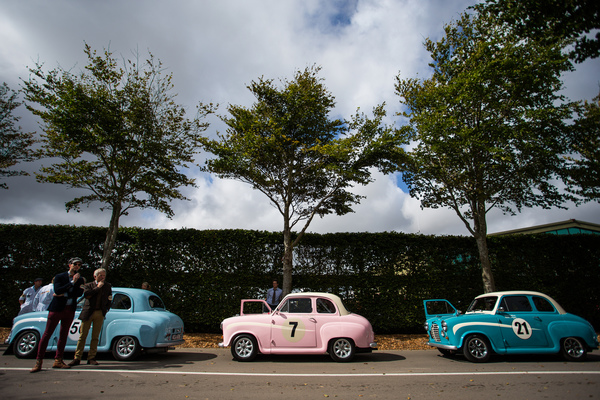
Sunday's Austin show was even better and more spectacular than Saturday's rainy one. After Ben Colburn left the leading group early on with a multiple rollover, his brother James was soon gone too.
Three riders battled it out for victory, which ultimately went to James Dorlin. Andrew Jordan's father Mike brought the winning car from the previous day to the finish line in third place and was thus crowned winner of the 2016 St Mary's Trophy together with his son after the two races were added together.
Like Frank Stippler the day before, David Franklin had to start from the back of the grid as the second driver in Alex Boller's Austin A35. Franklin's 17th place in the two races resulted in a respectable seventh place overall for this duo.
A Jaguar ahead of three AC Cobras
Like the Austins, the GT cars of the early 1960s were manned by professionals and experienced historic racers, who took turns at the wheel in pairs in the one-hour RAC TT Celebration Race.
In pole position was the Jaguar E-type of Brits Shedden and Ward, who had already attracted attention on Saturday and were surrounded by four AC Cobras. Ward handed the big cat over to Sheddon in the lead, who then had to succumb to the venomous snake of David Hart and final runner Giedo van der Garde.
After a safety car phase, the two cars merged and, like Frank Stippler and Oliver Bryant behind them, fought a great duel in their Cobras.
When "Flash Gordon" Shedden made contact with the leading Cobra of former Sauber GP driver van der Garde, thus not sending Gentleman like into the meadow, the Jaguar was the winner.
As in the previous year, Sheddon/Ward won Sunday's main race ahead of Squirle/Stippler and Smith/Bryant, who had moved up to second and third place, and Hart/Van der Garde. Wolfgang Friedrichs and Simon Hadfield finished tenth in Friedrichs' Aston Martin Project 212.
Lotus success story continues
The race of the Formula 1 racing cars, as they were used during the last Goodwood era until 1965 with the GP stars of the time at the wheel, could not be surpassed in terms of excitement. Miles Griffiths made the best start from the front row in his Lotus 24 BRM, but it was soon pole setter Martin Stretton who took command in an almost identical car.
The final two laps saw a showdown between Stretton and Nick Fennell in a Lotus 25-Climax. Because Stretton crossed the finish line with Fennell in the slipstream fractions of a second before the 20 minutes were up, there was another lap in which the final lead change took place due to gearshift problems on Stretton's Lotus-BRM and his crossover through the grass.
In the fastest race of the weekend (100.93 mph = 162.4 km/h average), Nick Fennell continued the winning streak of Classic Team Lotus, which has been unbeaten since 2011.
The performance of 76-year-old Richard Attwood, who brought his own 1965 BRM P261 home in fourth place behind the three Lotuses of Fennell, Stretton and Griffiths, was remarkable. Attwood was already on the grid here in the 1960s, and the fact that he can still be at the front 50 years later is more than impressive!
End with a bang
The final race of the 2016 Goodwood Revival Meeting, which was reserved for the large-volume sports cars from the 1955 and 60 World Championship era, ended prematurely after an accident with no serious consequences for the drivers, just like on Saturday. Right from the start, Chris Ward in the Lister Jaguar "Costin" took the lead ahead of the old warhorse Gary Pearson in the "Knobbly" of the same make. Ward celebrated his second Goodwood triumph in just a few hours and once again impressively demonstrated the supremacy of the British at this gigantic event.
The local spectators were just fine with this and the thousands of visitors from abroad, including many from German-speaking countries, like the chronicler, didn't really care. Because there is no better historic racing on offer anywhere in the world, including the Le Mans Classic and Oldtimer Grand Prix, so it doesn't matter who emerges as the deserving winner.
And if you want to experience this spectacle on and around the archaic race track live in 2017, it's best to contact Zwischengas, because they also know who organizes the best trips to Goodwood.


























































































































































































